此章语句参考语法以及选项的语义解释
ALTER DATABASE
Purpose
Use the ALTER DATABASE用于修改、维护或恢复现有数据库的语句。
See Also:
-
Oracle Database Backup and Recovery User's Guide for examples of performing media recovery
-
Oracle Data Guard Concepts and Administration for additional information on using the
ALTERDATABASEstatement to maintain standby databases -
CREATE DATABASE for information on creating a database
前提条件
您必须拥有ALTER数据库系统特权。
要指定startup_clause,还必须以SYSDBA、SYSOPER、ASSYSBACKUP或SYSDG连接。
要指定general_recovery子句,还必须具有SYSDBA或SYSBACKUPsystem特权。
要指定默认的EDITION子句,还必须具有指定版本上带有GRANTOPTION的USE object特权。
If you are connected to a multitenant container database (CDB):
-
要修改整个CDB,当前容器必须是根容器,并且必须具有通常授予的ALTER DATABASE特权。
要修改容器,它必须是当前容器,并且您必须拥有ALTERDATABASE特权,这些特权可以是通用的,也可以是容器中本地授予的。
Notes on Using ALTER DATABASE in a CDB
在连接到CDB时发出ALTER DATABASE语句时,语句的行为取决于当前容器和指定的子句。
如果当前容器是根容器,则使用以下子句修改整个CDB数据库语句。为了指定这些条款,您必须具有通常授予的ALTERDATABASE特权:
-
startup_clauses -
recovery_clausesNote: A subset of the
recovery_clausesare supported to back up and recover an individual pluggable database (PDB). In order to specify these clauses, you must have theALTERDATABASEprivilege, either granted commonly or granted locally in the PDB. Refer to "Notes on Using the recovery_clauses in a CDB" for more information. -
logfile_clauses -
controlfile_clauses -
standby_database_clauses -
instance_clauses -
security_clause -
RENAMEGLOBAL_NAMETO -
ENABLEBLOCKCHANGETRACKING -
DISABLEBLOCKCHANGETRACKING -
undo_mode_clause
如果当前容器是根,则使用以下子句修改数据库语句,只修改根。为了指定这些子句,您必须具有ALTER DATABASEprivilege,可以是普通授予的,也可以是根目录中本地授予的:
-
database_file_clauses -
DEFAULTEDITION -
DEFAULTTABLESPACE
如果当前容器是根目录,那么使用以下子句修改数据库语句,修改根目录并为PDBs设置默认值。为了指定这些子句,您必须具有通常授予的ALTER DATABASE特权:
-
DEFAULT[LOCAL]TEMPORARYTABLESPACE -
flashback_mode_clause -
SETDEFAULT{BIGFILE|SMALLFILE}TABLESPACE -
set_time_zone_clause
如果当前容器是PDB,则修改数据库语句来修改该PDB。在这种情况下,您只能发出ALTER PLUGGABLEDATABASE语句也支持的ALTER DATABASE子句。提供此功能是为了维护迁移到CDB环境的应用程序的向后兼容性。例外情况是修改PDB存储限制,对此必须使用ALTER PLUGGABLE数据库的pdb_storage_子句。有关这些子句的完整信息,请参阅关于ALTER PLUGGABLE数据库的文档。
Syntax
alter_database::=
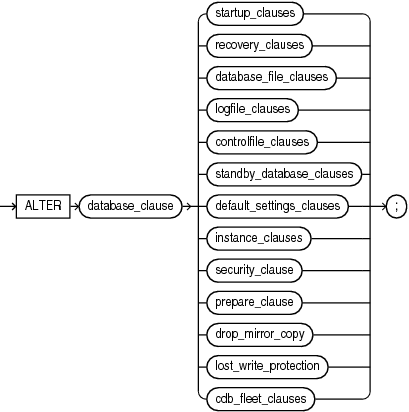
Description of the illustration alter_database.eps
Groups of ALTER DATABASE syntax:
database_clause::=

Description of the illustration database_clause.eps
startup_clauses::=

Description of the illustration startup_clauses.eps
recovery_clauses::=
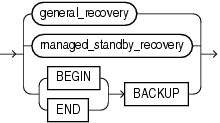
Description of the illustration recovery_clauses.eps
(general_recovery::=, managed_standby_recovery::=)
general_recovery::=

Description of the illustration general_recovery.eps
(full_database_recovery::=, partial_database_recovery::=, parallel_clause::=)
full_database_recovery::=
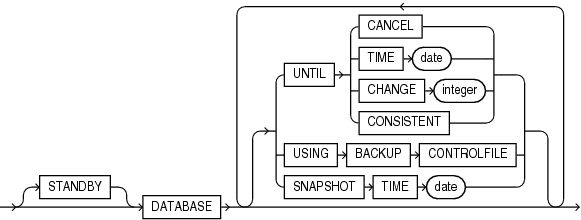
Description of the illustration full_database_recovery.eps
partial_database_recovery::=
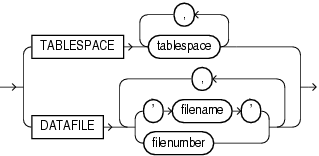
Description of the illustration partial_database_recovery.eps
parallel_clause::=

Description of the illustration parallel_clause.eps
managed_standby_recovery::=
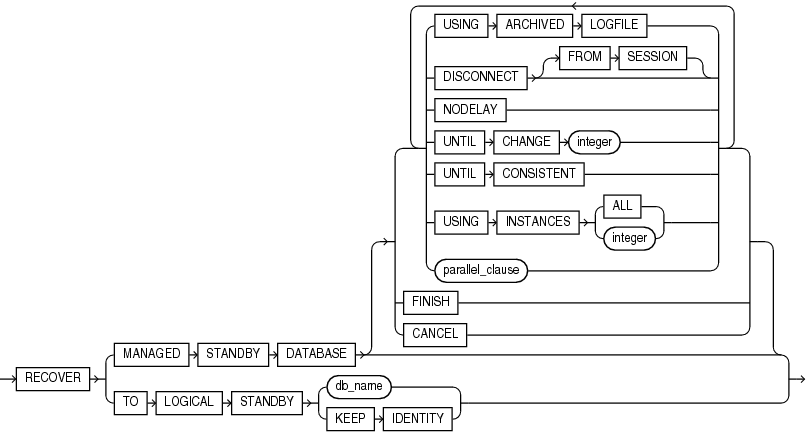
Description of the illustration managed_standby_recovery.eps
Note:
Several subclauses of managed_standby_recovery are no longer needed and have been deprecated. These clauses no longer appear in the syntax diagrams. Refer to the semantics of managed_standby_recovery.
database_file_clauses::=

Description of the illustration database_file_clauses.eps
(create_datafile_clause::=, alter_datafile_clause::=, alter_tempfile_clause::=, move_datafile_clause::=)
create_datafile_clause::=

Description of the illustration create_datafile_clause.eps
alter_datafile_clause::=

Description of the illustration alter_datafile_clause.eps
(autoextend_clause::=, size_clause::=)
alter_tempfile_clause::=

Description of the illustration alter_tempfile_clause.eps
(autoextend_clause::=, size_clause::=)
move_datafile_clause::=

Description of the illustration move_datafile_clause.eps
ASM_filename::=
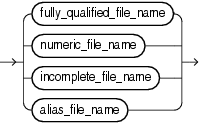
Description of the illustration asm_filename.eps
autoextend_clause::=

Description of the illustration autoextend_clause.eps
maxsize_clause::=

Description of the illustration maxsize_clause.eps
logfile_clauses::=
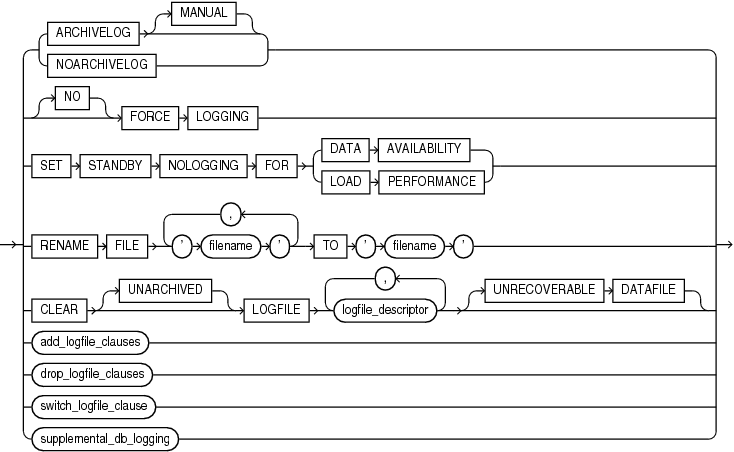
Description of the illustration logfile_clauses.eps
(logfile_descriptor::=, add_logfile_clauses::=, drop_logfile_clauses::=, switch_logfile_clause::=, supplemental_db_logging::=)
add_logfile_clauses::=
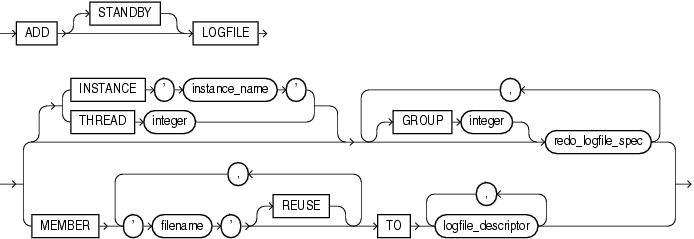
Description of the illustration add_logfile_clauses.eps
(redo_log_file_spec::=, logfile_descriptor::=)
drop_logfile_clauses::=

Description of the illustration drop_logfile_clauses.eps
switch_logfile_clause::=

Description of the illustration switch_logfile_clause.eps
supplemental_db_logging::=

Description of the illustration supplemental_db_logging.eps
(supplemental_id_key_clause::=)
supplemental_id_key_clause::=

Description of the illustration supplemental_id_key_clause.eps
supplemental_plsql_clause::=

Description of the illustration supplemental_plsql_clause.eps
logfile_descriptor::=
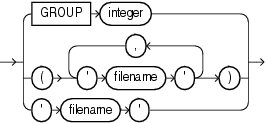
Description of the illustration logfile_descriptor.eps
controlfile_clauses::=

Description of the illustration controlfile_clauses.eps
trace_file_clause::=

Description of the illustration trace_file_clause.eps
standby_database_clauses::=

Description of the illustration standby_database_clauses.eps
(activate_standby_db_clause::=, maximize_standby_db_clause::=, register_logfile_clause::=, commit_switchover_clause::=, start_standby_clause::=, stop_standby_clause::=, convert_database_clause::=, parallel_clause::=, switchover_clause::=, failover_clause::=)
activate_standby_db_clause::=

Description of the illustration activate_standby_db_clause.eps
maximize_standby_db_clause::=

Description of the illustration maximize_standby_db_clause.eps
register_logfile_clause::=

Description of the illustration register_logfile_clause.eps
switchover_clause::=

Description of the illustration switchover_clause.eps
failover_clause::=

Description of the illustration failover_clause.eps
commit_switchover_clause::=
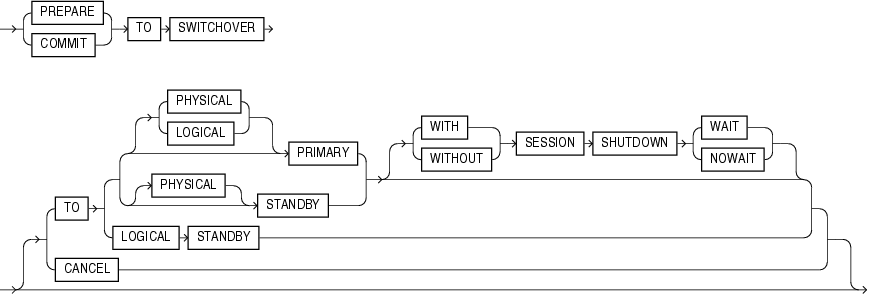
Description of the illustration commit_switchover_clause.eps
start_standby_clause::=
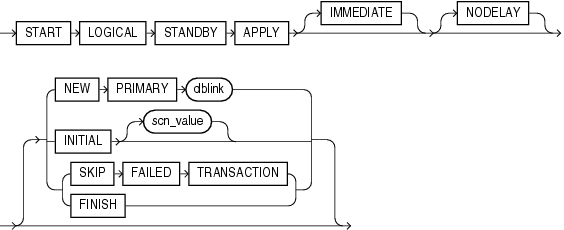
Description of the illustration start_standby_clause.eps
stop_standby_clause::=

Description of the illustration stop_standby_clause.eps
convert_database_clause::=

Description of the illustration convert_database_clause.eps
default_settings_clauses::=
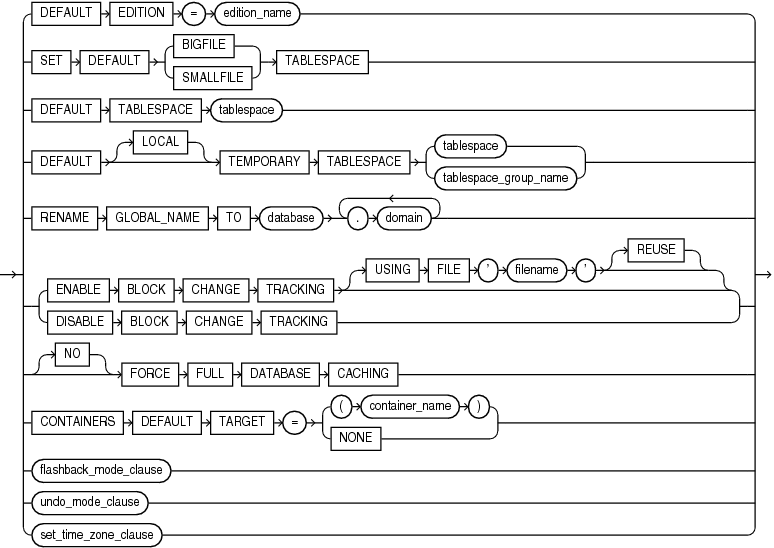
Description of the illustration default_settings_clauses.eps
(flashback_mode_clause::=, undo_mode_clause::=, set_time_zone_clause::=)
flashback_mode_clause::=

Description of the illustration flashback_mode_clause.eps
undo_mode_clause::=

Description of the illustration undo_mode_clause.eps
set_time_zone_clause::=

Description of the illustration set_time_zone_clause.eps
instance_clauses::=

Description of the illustration instance_clauses.eps
security_clause::=

Description of the illustration security_clause.eps
prepare_clause::=

Description of the illustration prepare_clause.eps
drop_mirror_copy::=

Description of the illustration drop_mirror_copy.eps
lost_write_protection ::=
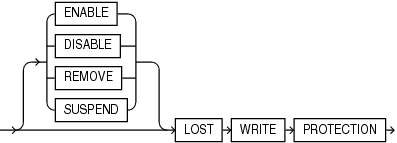
Description of the illustration lost_write_protection.eps
cdb_fleet_clauses::=

Description of the illustration cdb_fleet_clauses.eps
lead_cdb_clause::=

Description of the illustration lead_cdb_clause.eps
lead_cdb_uri_clause::=

Description of the illustration lead_cdb_uri_clause.eps
语义:
database_clause
为非容器数据库指定数据库选项.
db_name
指定要更改的数据库的名称。如果省略db_name,那么Oracle数据库将更改由初始化参数db_name的值标识的数据库。只能更改其控制文件由初始化参数CONTROL_FILES指定的数据库。数据库标识符与Oracle Net数据库规范无关。
startup_clauses
startup_clause允许挂载和打开数据库,以便用户可以访问它。
使用MOUNT子句挂载数据库。当数据库已经被装载时,不要使用这个子句。
MOUNT STANDBY DATABASE
可以指定挂载备用数据库以挂载物理备用数据库。关键字备用数据库是可选的,因为Oracle数据库自动确定要挂载的数据库是主数据库还是备用数据库。一旦执行此语句,备用实例就可以从主实例接收重做数据。
See Also:
Oracle Data Guard Concepts and Administration for more information on standby databases
MOUNT CLONE DATABASE
Specify MOUNT CLONE DATABASE to mount the clone database.
使用OPEN子句使数据库可以正常使用。在打开数据库之前,必须先挂载它。
如果只指定OPEN而不指定任何其他关键字,那么默认是在主数据库、逻辑备用数据库或快照备用数据库上打开读WRITENORESETLOGS,并在物理备用数据库上只打开读。
OPEN READ WRITE
指定OPEN READ WRITE以读/写模式打开数据库,允许用户生成重做日志。如果您正在打开主数据库,这是默认设置。不能为物理备用数据库指定此子句。
See Also:
"READ ONLY / READ WRITE: Example"
RESETLOGS | NORESETLOGS
此子句确定Oracle数据库是否将当前日志序列号重置为1,是否归档任何未归档日志(包括当前日志),以及是否丢弃在恢复期间未应用的任何重做信息,以确保永远不会应用这些信息。Oracle数据库自动使用noresetlogsautomatic,除非在以下特定情况下,需要对该子句进行设置:
-
You must specify
RESETLOGS:-
在使用备份控制文件执行不完全媒体恢复或媒体恢复之后
在之前的OPEN RESETLOGS操作未完成之后
闪回数据库操作后
-
-
如果挂载了创建的控制文件,那么如果联机日志丢失,则必须指定RESETLOGS;如果没有丢失,则必须指定NORESETLOGS。
只有在升级或降级数据库时才使用这些OPEN子句参数。这个子句指示Oracle数据库根据升级和降级的需要分别动态修改系统参数。您可以使用SQL*Plus启动升级或启动降级命令来实现相同的结果。
当您为CDB使用升级或降级参数时,根容器将以指定模式打开,但是所有其他容器将以读/写模式打开。
See Also:
-
Oracle Database Upgrade Guide for information on the steps required to upgrade or downgradea database from one release to another
-
SQL*Plus User's Guide and Reference for information on the SQL*Plus
STARTUPcommand
OPEN READ ONLY
指定OPEN READ ONLY将用户限制为只读事务,防止用户生成重做日志。此设置是打开物理备用数据库时的默认设置,以便在从主数据库站点复制归档日志时,物理备用数据库也可以用于查询。
限制条件on Opening a Database
The following restrictions apply to opening a database:
-
如果数据库当前由另一个实例以READ WRITEmode方式打开,则不能以只读模式打开该数据库。
如果数据库需要恢复,则不能以只读模式打开数据库。
在数据库以只读模式打开时,不能脱机表空间。但是,您可以脱机或联机获取数据文件,并且可以在数据库以只读模式打开时恢复脱机数据文件和表空间。See Also:
Oracle Data Guard Concepts and Administration for additional information about opening a physical standby database
recovery_clauses
recovery_clause包括备份后操作。对于所有这些子句,Oracle Database使用当前控制文件所知道的任何数据文件和日志文件的化身来恢复数据库。
See Also:
Oracle Database Backup and Recovery User's Guide for information on backing up the database and "Database Recovery: Examples"
Notes on Using the recovery_clauses in a CDB
当当前容器是根容器时,您可以指定所有recovery_clause来备份和恢复整个CDB。
当当前容器是PDB时,您可以指定recovery_clause的以下子句来备份和恢复PDB:
-
BEGINBACKUP -
ENDBACKUP -
full_database_recovery: You can specify only theDATABASEkeyword -
partial_database_recovery -
The
LOGFILEandCONTINUEclauses ofgeneral_recovery
You can also specify the preceding subclauses using the pdb_recovery_clauses of ALTERPLUGGABLE DATABASE. Refer to the syntax diagram pdb_recovery_clauses of ALTER PLUGGABLEDATABASE.
general_recovery
general_recovery子句允许控制数据库或备用数据库或指定表空间或文件的媒体恢复。当实例挂载、打开或关闭数据库,且涉及的文件未使用时,可以使用此子句。
Note:
在完全或部分数据库恢复和日志文件恢复期间,默认情况下启用并行性。数据库计算并行度。您可以通过指定NOPARALLEL来禁用这些操作的并行性,或者使用PARALLELinteger指定一定程度的并行性,如各自的语法图所示。
General recovery is subject to the following restrictions:
-
只有在数据库关闭时才能恢复整个数据库。
实例必须将数据库挂载在排他模式下。
如果要恢复的表空间或数据文件脱机,则可以在数据库打开或关闭时恢复表空间或数据文件。
如果通过共享服务器架构连接到Oracle数据库,则无法执行媒体恢复。
See Also:
-
Oracle Database Backup and Recovery User's Guide for more information on RMAN media recovery and user-defined media recovery
-
SQL*Plus User's Guide and Reference for information on the SQL*Plus
RECOVERcommand
如果希望Oracle数据库自动生成继续恢复操作所需的下一个归档重做日志文件的名称,请指定AUTOMATIC。如果定义了LOG_ARCHIVE_DEST_nparameters,那么Oracle数据库将扫描那些对第一个本地目的地有效并启用的参数。它将目标与LOG_ARCHIVE_FORMAT一起生成目标重做日志文件名。如果没有定义LOG_ARCHIVE_DEST_n参数,那么Oracle数据库将使用LOG_ARCHIVE_DEST参数的值。
如果找到结果文件,则Oracle数据库应用该文件中包含的重做。如果没有找到该文件,那么Oracle数据库会提示您输入文件名,并将生成的文件名显示为建议。
如果您既不指定AUTOMATIC也不指定LOGFILE,那么Oracle数据库将提示您输入文件名,并将生成的文件名显示为建议。然后可以接受生成的文件名,或者用完全限定的文件名替换它。如果您知道归档的文件名不同于Oracle数据库将生成的文件名,那么您可以使用LOGFILE子句节省时间。
从'location'指定以指示从哪个位置读取归档的重做日志文件组。location的值必须是完全指定的文件位置,符合操作系统的约定。如果忽略此参数,那么Oracle数据库假定归档的重做日志文件组位于初始化参数LOG_ARCHIVE_DEST或LOG_ARCHIVE_DEST_1指定的位置。
full_database_recovery
full_database_recovery子句允许恢复整个数据库。
指定DATABASE子句来恢复整个数据库。这是默认值。您只能在数据库关闭时使用此子句。
STANDBY DATABASE
指定备用数据库子句,使用从主数据库复制的控制文件和归档的重做日志文件手动恢复物理备用数据库。必须挂载备用数据库,但不能打开。
This clause recovers only online data files.
-
Use the
UNTILclause to specify the duration of the recovery operation.-
CANCEL表示基于CANCEL的恢复。这个子句恢复数据库,直到您使用recovery CANCEL子句发出ALTER database语句。
时间表示基于时间的恢复。该参数将数据库恢复到日期指定的时间。日期必须是“YYYY-MM-DD:HH24:MI:SS”格式的字符文字。
更改表示基于更改的恢复。该参数在integer指定的系统更改号之前立即将数据库恢复到事务一致状态。
恢复数据库,直到所有在线文件都恢复到一致的S
-
-
如果您想使用备份控制文件而不是当前控制文件,请指定使用备份控制文件。
指定SNAPSHOT TIME子句,以便使用存储快照优化使用存储快照恢复数据库。在创建存储快照时数据库没有处于备份模式的情况下,可以使用此子句。-
日期必须是“YYYY-MM-DD:HH24:MI:SS”格式的字符文字。它必须表示快照完成后的一个时间。如果指定UNTIL TIME子句,则快照时间日期必须早于UNTIL时间日期。
See Also:
Oracle Database Backup and Recovery User's Guide for more information on recovery using Storage Snapshot Optimization
-
partial_database_recovery
partial_database_recovery子句允许恢复单个表空间和数据文件。
指定TABLESPACE子句只恢复指定的表空间。如果数据库是打开或关闭的,则可以使用此子句,前提是要恢复的表空间是脱机的。
See Also:
"Using Parallel Recovery Processes: Example"
指定DATAFILE子句来恢复指定的数据文件。如果要恢复的数据文件脱机,则在数据库打开或关闭时可以使用此子句。
您可以通过名称或编号识别数据文件。如果按数字标识,那么filenumberis是一个整数,表示在V$DATAFILE动态性能视图的FILE#列或DBA_DATA_FILES数据字典视图的FILE_ID列中找到的数字。
STANDBY {TABLESPACE | DATAFILE}
在早期版本中,您可以指定备用表空间或备用数据文件来恢复备用数据库中特定表空间或特定数据文件的旧备份,以便与备用数据库的其余部分保持一致。这两个子句现在被取消了支持。相反,要将备用数据库恢复到一致的点,但不能进一步,请使用语句ALTER database RECOVERMANAGED备用数据库,直到一致为止。
通过应用指定的重做日志文件,指定日志文件'filename'以继续媒体恢复。
使用TEST子句进行试收回。如果正常的恢复过程遇到了一些问题,尝试恢复是有用的。它让您提前查看重做流,以检测可能的其他问题。尝试恢复以类似于正常恢复的方式应用redo,但它不会将更改写入磁盘,并且在尝试恢复结束时回滚其更改。
只有在恢复了自上次RESETLOGS操作以来的备份之后,才能使用此子句。否则,Oracle数据库返回错误。
ALLOW integer CORRUPTION子句允许您在日志文件损坏的情况下指定允许恢复进行时可以容忍的损坏块的数量。
See Also:
-
Oracle Database Backup and Recovery User's Guide for information on database recovery in general
-
Oracle Data Guard Concepts and Administration for information on managed recovery of standby databases
指定在中断多实例恢复以禁用线程后继续恢复。
如果没有指定其他日志文件,则使用Oracle数据库将自动生成的重做日志文件指定CONTINUE DEFAULT以继续恢复。这个子句等价于指定AUTOMATIC,但是Oracle数据库不提示输入文件名。
指定CANCEL终止基于CANCEL的恢复。
managed_standby_recovery
使用managed_standby_recovery子句在物理备用数据库上启动和停止重新执行应用程序。Redo Apply通过不断应用从主数据库接收到的Redo,使备用数据库与主数据库在事务上保持一致。
主数据库将重做数据传输到备用站点。当重做数据被写入物理备用站点上的重做日志文件时,日志文件可以被重做应用程序使用。当备用实例挂载数据库或以只读方式打开时,可以使用managed_standby_recovery子句。
Note:
从Oracle数据库12c开始,在重做应用期间,在默认情况下启用实时应用。Real-time apply在写入备用重做日志文件后立即从它们恢复重做,而不需要先将它们归档到物理备用数据库。可以使用USING ARCHIVED LOGFILE子句禁用实时应用。请参考:
-
Oracle Data Guard Concepts and Administration for more information on real-time apply
Note:
在重做应用期间,默认情况下启用并行性。数据库计算并行度。您可以通过指定NOPARALLEL来禁用这些操作的并行性,或者使用并行整数指定一定程度的并行性,如各自的语法图所示。
对托管备用恢复的限制
general_recovery下列出的限制同样适用于此子句。
See Also:
Oracle Data Guard Concepts and Administration for more information on the use of this clause
USING ARCHIVED LOGFILE Clause
在不启用实时应用的情况下,指定使用归档日志文件启动重新执行应用。
指定DISCONNECT以指示应在后台执行重做应用程序,使当前会话可用于其他任务。FROM会话关键字是可选的,并提供了语义清晰度。
NODELAY
NODELAY子句覆盖主数据库上LOG_ARCHIVE_DEST_n参数上的DELAY属性。如果没有指定NODELAY子句,那么归档的重做日志文件的应用程序将根据LOG_ARCHIVE_DEST_n设置(如果有)的DELAY属性延迟。如果在该参数上没有指定DELAY属性,那么归档的重做日志文件将立即应用到备用数据库。
如果使用USING CURRENT LOGFILE子句指定real-time apply,那么将忽略此备用服务器的主服务器上为LOG_ARCHIVE_DEST_n参数指定的任何延迟值,NODELAY是默认值。
UNTIL CHANGE Clause
使用此子句指示重做应用程序恢复重做数据,但不包括指定的系统更改号。
UNTIL CONSISTENT
使用此子句将备用数据库恢复到一致的SCN点,以便以只读模式打开备用数据库。
USING INSTANCES
This clause is applicable only for Oracle Real Application Clusters (Oracle RAC) or Oracle RAC One Node databases and allows you to start apply processes on multiple instances of the standby that are started in the same mode (MOUNTED or READ ONLY) as the instance on which the command is executed. Specify USING INSTANCES ALL to perform Redo Apply on all instances in an Oracle RAC standby database started in the same mode. Specify USING INSTANCES integer to perform Redo Apply on the specified number of instances that are started in the same mode. For integer, specify an integer value from 1 to the number of instances in the standby database. The database chooses the instances on which to perform Redo Apply; you cannot specify particular instances. For example, if you specify 4 instances from an instance that is MOUNTED and only 3 instances of the standby are running in the MOUNTED mode, then Redo Apply will only be started on 3 instances. If you omit the USINGINSTANCES clause, then Oracle Database performs Redo Apply only on the instance where the command was executed.
Specify FINISH to complete applying all available redo data in preparation for a failover.
Use the FINISH clause only in the event of the failure of the primary database. This clause overrides any specified delay intervals and applies all available redo immediately. After the FINISH command completes, this database can no longer run in the standby database role, and it must be converted to a primary database by issuing the ALTER DATABASE COMMIT TO SWITCHOVER TO PRIMARYstatement.
Specify CANCEL to stop Redo Apply immediately. Control is returned as soon as Redo Apply stops.
Use this clause to convert a physical standby database into a logical standby database.
db_name
Specify a database name to identify the new logical standby database. If you are using a server parameter file (spfile) at the time you issue this statement, then the database will update the file with appropriate information about the new logical standby database. If you are not using an spfile, then the database issues a message reminding you to set the name of the DB_NAME parameter after shutting down the database. In addition, you must invoke the DBMS_LOGSTDBY.BUILD PL/SQL procedure on the primary database before using this clause on the standby database.
See Also:
Oracle Database PL/SQL Packages and Types Reference for information about the DBMS_LOGSTDBY.BUILD procedure
KEEP IDENTITY
Use this clause if you want to use the rolling upgrade feature provided by a logical standby and also revert to the original configuration of a primary database and a physical standby. A logical standby database created using this clause provides only limited support for switchover and failover. Therefore, do not use this clause create a general-purpose logical standby database.
See Also:
Oracle Data Guard Concepts and Administration for more information on rolling upgrade
Deprecated Managed Standby Recovery Clauses
The following clauses appeared in the syntax of earlier releases. They have been deprecated and are no longer needed. Oracle recommends that you do not use these clauses.
FINISH FORCE, FINISH WAIT, FINISH NOWAIT
These optional forms of the FINISH clause are deprecated. Their semantics are presented here for backward compatibility:
-
FORCEterminates inactive redo transport sessions that would otherwise preventFINISHprocessing from beginning. -
NOWAITreturns control to the foreground process before the recovery completes -
WAIT(the default) returns control to the foreground process after recovery completes
When specified, these clauses are ignored. Terminal recovery now runs in the foreground and always terminates all redo transport sessions. Therefore control is not returned to the user until recovery completes.
CANCEL IMMEDIATE, CANCEL WAIT, CANCEL NOWAIT
These optional forms of the CANCEL clause are deprecated. Their semantics are presented here for backward compatibility:
-
Include the
IMMEDIATEkeyword to stop Redo Apply before completely applying the current redo log file. Session control returns when Redo Apply actually stops. -
Include the
NOWAITkeyword to return session control without waiting for theCANCELoperation to complete.
When specified, these clauses are ignored. Redo Apply is now always cancelled immediately and control returns to the session only after the operation completes.
USING CURRENT LOGFILE Clause
The USING CURRENT LOGFILE clause is deprecated. It invokes real-time apply during Redo Apply. However, this is now the default behavior and this clause is no longer useful.
Use these clauses to move all the data files in the database into or out of online backup mode (also called hot backup mode).
See Also:
ALTER TABLESPACE for information on moving all data files in an individual tablespace into and out of online backup mode
BEGIN BACKUP Clause
Specify BEGIN BACKUP to move all data files in the database into online backup mode. The database must be mounted and open, and media recovery must be enabled (the database must be in ARCHIVELOG mode).
While the database is in online backup mode, you cannot shut down the instance normally, begin backup of an individual tablespace, or take any tablespace offline or make it read only.
This clause has no effect on data files that are in offline or on read-only tablespaces.
END BACKUP Clause
Specify END BACKUP to take out of online backup mode any data files in the database currently in online backup mode. The database must be mounted (either open or closed) when you perform this operation.
After a system failure, instance failure, or SHUTDOWN ABORT operation, Oracle Database does not know whether the files in online backup mode match the files at the time the system crashed. If you know the files are consistent, then you can take either individual data files or all data files out of online backup mode. Doing so avoids media recovery of the files upon startup.
-
To take an individual data file out of online backup mode, use the
ALTERDATABASEDATAFILE...ENDBACKUPstatement. See database_file_clauses. -
To take all data files in a tablespace out of online backup mode, use an
ALTERTABLESPACE...ENDBACKUPstatement.
database_file_clauses
The database_file_clauses let you modify data files and temp files. You can use any of the following clauses when your instance has the database mounted, open or closed, and the files involved are not in use. The exception is the move_datafile_clause, which allows you to move a data file that is in use.
Use the RENAME FILE clause to rename data files, temp files, or redo log file members. You must create each filename using the conventions for filenames on your operating system before specifying this clause.
-
To use this clause for a data file or temp file, the database must be mounted. The database can also be open, but the data file or temp file being renamed must be offline. In addition, you must first rename the file on the file system to the new name.
-
To use this clause for logfiles, the database must be mounted but not open.
-
If you have enabled block change tracking, then you can use this clause to rename the block change tracking file. The database must be mounted but not open when you rename the block change tracking file.
This clause renames only files in the control file. It does not actually rename them on your operating system. The operating system files continue to exist, but Oracle Database no longer uses them.
See Also:
-
Oracle Database Backup and Recovery User's Guide for information on recovery of data files and temp files
-
"Renaming a Log File Member: Example" and "Manipulating Temp Files: Example"
create_datafile_clause
Use the CREATE DATAFILE clause to create a new empty data file in place of an old one. You can use this clause to re-create a data file that was lost with no backup. The filename or filenumbermust identify a file that is or was once part of the database. If you identify the file by number, then filenumber is an integer representing the number found in the FILE# column of the V$DATAFILE dynamic performance view or in the FILE_ID column of the DBA_DATA_FILESdata dictionary view.
-
Specify
ASNEWto create an Oracle-managed data file with a system-generated filename, the same size as the file being replaced, in the default file system location for data files. -
Specify
ASfile_specificationto assign a file name (and optional size) to the new data file. Use thedatafile_tempfile_specform offile_specification(see file_specification) to list regular data files and temp files in an operating system file system or to list Oracle Automatic Storage Management (Oracle ASM) disk group files.
If the original file (filename or filenumber) is an existing Oracle-managed data file, then Oracle Database attempts to delete the original file after creating the new file. If the original file is an existing user-managed data file, then Oracle Database does not attempt to delete the original file.
If you omit the AS clause entirely, then Oracle Database creates the new file with the same name and size as the file specified by filename or filenumber.
During recovery, all archived redo logs written to since the original data file was created must be applied to the new, empty version of the lost data file.
Oracle Database creates the new file in the same state as the old file when it was created. You must perform media recovery on the new file to return it to the state of the old file at the time it was lost.
Restrictions on Creating New Data Files
The creation of new data files is subject to the following restrictions:
-
You cannot create a new file based on the first data file of the
SYSTEMtablespace. -
You cannot specify the
autoextend_clauseofdatafile_tempfile_specin thisCREATEDATAFILEclause.
See Also:
-
"DATAFILE Clause" of
CREATEDATABASEfor information on the result of this clause if you do not specify a name for the new data file -
file_specification for a full description of the file specification (
datafile_tempfile_spec) and "Creating a New Data File: Example"
alter_datafile_clause
The DATAFILE clause lets you manipulate a file that you identify by name or by number. If you identify it by number, then filenumber is an integer representing the number found in the FILE#column of the V$DATAFILE dynamic performance view or in the FILE_ID column of the DBA_DATA_FILES data dictionary view. The DATAFILE clauses affect your database files as follows:
ONLINE
Specify ONLINE to bring the data file online.
OFFLINE
Specify OFFLINE to take the data file offline. If the database is open, then you must perform media recovery on the data file before bringing it back online, because a checkpoint is not performed on the data file before it is taken offline.
FOR DROP
If the database is in NOARCHIVELOG mode, then you must specify FOR DROP clause to take a data file offline. However, this clause does not remove the data file from the database. To do that, you must use an operating system command or drop the tablespace in which the data file resides. Until you do so, the data file remains in the data dictionary with the status RECOVER or OFFLINE.
If the database is in ARCHIVELOG mode, then Oracle Database ignores the FOR DROP clause.
RESIZE
Specify RESIZE if you want Oracle Database to attempt to increase or decrease the size of the data file to the specified absolute size in bytes. There is no default, so you must specify a size. You can also use this command to resize datafiles in shadow tablespaces, that store lost write data.
If sufficient disk space is not available for the increased size, or if the file contains data beyond the specified decreased size, then Oracle Database returns an error.
See Also:
"Resizing a Data File: Example"
END BACKUP
Specify END BACKUP to take the data file out of online backup mode. The END BACKUP clause is described more fully at the top level of the syntax of ALTER DATABASE. See "END BACKUP Clause".
ENCRYPT | DECRYPT
Use these clauses to perform offline encryption or decryption of the data file using Transparent Data Encryption (TDE). In any given tablespace, either all data files must be encrypted or all data files must be unencrypted.
Before issuing either of these clauses, the database must be mounted. The database can also be open, but the tablespace that contains the data file being encrypted or decrypted must be offline. The TDE master key must be loaded into database memory.
-
Specify
ENCRYPTto encrypt an unencrypted data file. The data file is encrypted using theAES128algorithm. -
Specify
DECRYPTto decrypt a data file. The data file must have been previously encrypted with theALTERDATABASEDATAFILE...ENCRYPTstatement.
Restrictions on Encrypting and Decrypting Data Files
The following restrictions apply to the ENCRYPT and DECRYPT clauses:
-
You cannot encrypt or decrypt a temporary data file of a temporary tablespace. Instead, you must drop the temporary tablespace and recreate it as an encrypted tablespace.
-
Oracle recommends against encrypting the data files of an undo tablespace. Doing so prevents the keystore from being closed, which prevents the database from functioning. Furthermore, this practice is unnecessary because all undo records that are associated with an encrypted tablespace are already automatically encrypted in the undo tablespace.
Note:
The use of the ENCRYPT or DECRYPT clause is only one step in a series of steps for performing offline encryption or decryption of a data file. Refer to Oracle Database Advanced Security Guide for the complete set of steps before you use either of these clauses.
alter_tempfile_clause
Use the TEMPFILE clause to resize your temporary data file or specify the autoextend_clause, with the same effect as for a permanent data file. The database must be open. You can identify the temp file by name or by number. If you identify it by number, then filenumber is an integer representing the number found in the FILE# column of the V$TEMPFILE dynamic performance view.
Note:
On some operating systems, Oracle does not allocate space for a temp file until the temp file blocks are actually accessed. This delay in space allocation results in faster creation and resizing of temp files, but it requires that sufficient disk space is available when the temp files are later used. To avoid potential problems, before you create or resize a temp file, ensure that the available disk space exceeds the size of the new temp file or the increased size of a resized temp file. The excess space should allow for anticipated increases in disk space use by unrelated operations as well. Then proceed with the creation or resizing operation.
DROP
Specify DROP to drop tempfile from the database. The tablespace remains.
If you specify INCLUDING DATAFILES, then Oracle Database also deletes the associated operating system files and writes a message to the alert log for each such deleted file. You can achieve the same result using an ALTER TABLESPACE ... DROP TEMPFILE statement. Refer to the ALTERTABLESPACE DROP Clause for more information.
move_datafile_clause
Use the MOVE DATAFILE clause to move an online data file to a new location. The database can be open and accessing the data file when you perform this operation. The database creates a copy of the data file when it is performing this operation. Ensure that there is adequate disk space for the original data file and the copy before using this clause.
You can specify the original data file using the file_name, ASM_filename, or file_number. Refer to ASM_filename for information on ASM file names. If you identify the file by number, then file_number is an integer representing the number found in the FILE# column of the V$DATAFILE dynamic performance view or in the FILE_ID column of the DBA_DATA_FILESdata dictionary view.
Use the TO clause to specify the new file_name or ASM_filename. If you are using Oracle Managed Files, then you can omit the TO clause. In this case, Oracle Database creates a unique name for the data file and saves it in the directory specified by the DB_CREATE_FILE_DEST initialization parameter.
If you specify REUSE, then the new data file is created even if it already exists.
If you specify KEEP, then the original data file will be kept after the MOVE DATAFILE operation. You cannot specify KEEP if the original data file is an Oracle Managed File. You can specify KEEP if the new data file is an Oracle Managed File.
autoextend_clause
Use the autoextend_clause to enable or disable the automatic extension of a new or existing data file or temp file. Refer to file_specification for information about this clause.
logfile_clauses
The logfile clauses let you add, drop, or modify log files.
Specify ARCHIVELOG if you want the contents of a redo log file group to be archived before the group can be reused. This mode prepares for the possibility of media recovery. Use this clause only after shutting down your instance normally, or immediately with no errors, and then restarting it and mounting the database.
MANUAL
Specify MANUAL to indicate that Oracle Database should create redo log files, but the archiving of the redo log files is controlled entirely by the user. This clause is provided for backward compatibility, for example for users who archive directly to tape. If you specify MANUAL, then:
-
Oracle Database does not archive redo log files when a log switch occurs. You must handle this manually.
-
You cannot have specified a standby database as an archivelog destinations. As a result, the database cannot be in
MAXIMUMPROTECTIONorMAXIMUMAVAILABILITYstandby protection mode.
If you omit this clause, then Oracle Database automatically archives the redo log files to the destination specified in the LOG_ARCHIVE_DEST_n initialization parameters.
NOARCHIVELOG
Specify NOARCHIVELOG if you do not want the contents of a redo log file group to be archived so that the group can be reused. This mode does not prepare for recovery after media failure. Use this clause only if your instance has the database mounted but not open.
Use this clause to put the database into or take the database out of FORCE LOGGING mode. The database must be mounted or open.
In FORCE LOGGING mode, Oracle Database logs all changes in the database except changes in temporary tablespaces and temporary segments. This setting takes precedence over and is independent of any NOLOGGING or FORCE LOGGING settings you specify for individual tablespaces and any NOLOGGING settings you specify for individual database objects.
If you specify FORCE LOGGING, then Oracle Database waits for all ongoing unlogged operations to finish.
See Also:
Oracle Database Administrator's Guide for information on when to use FORCE LOGGING mode
SET STANDBY NOLOGGING
Standby nologging instructs the database to not log operations that qualify to be done without logging. The database sends the data blocks created by the operation to each qualifying standby database in the Data Guard configuration, to prevent missed data on the standby and keep it in sync with the primary.
Use this clause to determine how nonlogged tasks are handled . You can choose one of two logging modes for a database when you create the database, and you can change the logging mode of a database from one mode to the other.
-
SET STANDBY NOLOGGING FOR LOAD PERFORMANCEto put the database into standby nologging for load performance mode. In this mode, the data loaded as part of the nonlogged task is sent to the qualifying standbys via a private network connection, provided that doing so will not slow down the load process. If the load process slows, then the data is not sent but automatically fetched from the primary as each standby encounters the invalidation redo and will be retried until the data blocks are eventually received. -
Specify
SET STANDBY NOLOGGING FOR DATA AVAILABILITYto put the database into standby nologging for data availability mode. In this mode the data loaded as part of the nonlogged task is sent to the qualifying standbys either via a network connection or via block images in the redo, in case the network connection fails. That is to say, in this mode the load will switch to be done in a logged fashion if the network connection or related processes prevent the sending of the data over the private network connection.
For the standby nologging modes, a qualifying standby is one that is open for read, running managed recovery and receiving redo into standby redo logs.
Restrictions on Setting Standby Nologging
TheSET STANDBY NOLOGGING clause cannot be used at the same time as FORCE LOGGING.
RENAME FILE Clause
This clause has the same function for logfiles that it has for data files and temp files. See "RENAME FILE Clause".
Use the CLEAR LOGFILE clause to reinitialize an online redo log, optionally without archiving the redo log. CLEAR LOGFILE is similar to adding and dropping a redo log, except that the statement may be issued even if there are only two logs for the thread and may be issued for the current redo log of a closed thread.
For a standby database, if the STANDBY_FILE_MANAGEMENT initialization parameter is set to AUTO, and if any of the log files are Oracle Managed Files, Oracle Database will create as many Oracle-managed log files as are in the control file. The log file members will reside in the current default log file destination.
-
You must specify
UNARCHIVEDif you want to reuse a redo log that was not archived.Note:
Specifying
UNARCHIVEDmakes backups unusable if the redo log is needed for recovery. -
You must specify
UNRECOVERABLEDATAFILEif you have taken the data file offline with the database inARCHIVELOGmode (that is, you specifiedALTERDATABASE...DATAFILEOFFLINEwithout theDROPkeyword), and if the unarchived log to be cleared is needed to recover the data file before bringing it back online. In this case, you must drop the data file and the entire tablespace once theCLEARLOGFILEstatement completes.Do not use
CLEARLOGFILEto clear a log needed for media recovery. If it is necessary to clear a log containing redo after the database checkpoint, then you must first perform incomplete media recovery. The current redo log of an open thread can be cleared. The current log of a closed thread can be cleared by switching logs in the closed thread.If the
CLEARLOGFILEstatement is interrupted by a system or instance failure, then the database may hang. In this case, reissue the statement after the database is restarted. If the failure occurred because of I/O errors accessing one member of a log group, then that member can be dropped and other members added.See Also:
add_logfile_clauses
Use these clauses to add redo log file groups to the database and to add new members to existing redo log file groups.
ADD LOGFILE Clause
Use the ADD LOGFILE clause to add one or more redo log file groups to the online redo log or standby redo log.
See Also:
-
"LOGFILE Clause" of
CREATEDATABASEfor information on the result of this clause for Oracle Managed Files if you do not specify a name for the new log file group -
Oracle Data Guard Concepts and Administration for more information on standby redo logs
STANDBY
Use the STANDBY clause to add a redo log file group to the standby redo log. If you do not specify this clause, then a log file group is added to the online redo log.
The INSTANCE clause is applicable only for Oracle Real Application Clusters (Oracle RAC) or Oracle RAC One Node databases. Specify the name of the instance for which you want to add a redo log file group. The instance name is a string of up to 80 characters. Oracle Database automatically uses the thread that is mapped to the specified instance. If no thread is mapped to the specified instance, then Oracle Database automatically acquires an available unmapped thread and assigns it to that instance. If you do not specify this clause, then Oracle Database executes the command as if you had specified the current instance. If the specified instance has no current thread mapping and there are no available unmapped threads, then Oracle Database returns an error.
When adding a redo log file group to the standby redo log, use the THREAD clause to assign the log file group to a specific primary database redo thread. Query the V$INSTANCE view on the primary database to determine which redo threads have been opened, and specify one of these thread numbers.
You can also use the THREAD clause to assign a log file group to a specific redo thread when adding the log file group to the online redo log. This usage has been deprecated. The INSTANCE clause achieves the same purpose and is easier to use.
The GROUP clause uniquely identifies the redo log file group among all groups in all threads and can range from 1 to the value specified for MAXLOGFILES in the CREATE DATABASE statement. You cannot add multiple redo log file groups having the same GROUP value. If you omit this parameter, then Oracle Database generates its value automatically. You can examine the GROUP value for a redo log file group through the dynamic performance view V$LOG.
redo_log_file_spec
Each redo_log_file_spec specifies a redo log file group containing one or more members (copies). If you do not specify a filename for the new log file, then Oracle Database creates Oracle Managed Files according to the rules described in the "LOGFILE Clause" of CREATE DATABASE.
See Also:
-
Oracle Database Reference for information on dynamic performance views
Use the ADD LOGFILE MEMBER clause to add new members to existing redo log file groups. Each new member is specified by 'filename'. If the file already exists, then it must be the same size as the other group members and you must specify REUSE. If the file does not exist, then Oracle Database creates a file of the correct size. You cannot add a member to a group if all of the members of the group have been lost through media failure.
STANDBY
You must specify STANDBY when adding a member to a standby redo log file group. Otherwise, Oracle Database returns an error.
You can use the logfile_descriptor clause to specify an existing redo log file group in one of two ways:
GROUP integer
Specify the value of the GROUP parameter that identifies the redo log file group.
filename(s)
List all members of the redo log file group. You must fully specify each filename according to the conventions of your operating system.
See Also:
-
"LOGFILE Clause" of
CREATEDATABASEfor information on the result of this clause for Oracle Managed Files if you do not specify a name for the new log file group
drop_logfile_clauses
Use these clauses to drop redo log file groups or redo log file members.
DROP LOGFILE Clause
Use the DROP LOGFILE clause to drop all members of a redo log file group. If you use this clause to drop Oracle Managed Files, then Oracle Database also removes all log file members from disk. Specify a redo log file group as indicated for the ADD LOGFILE MEMBER clause.
-
To drop the current log file group, you must first issue an
ALTERSYSTEMSWITCHLOGFILEstatement. -
You cannot drop a redo log file group if it needs archiving.
-
You cannot drop a redo log file group if doing so would cause the redo thread to contain less than two redo log file groups.
See Also:
Use the DROP LOGFILE MEMBER clause to drop one or more redo log file members. Each 'filename' must fully specify a member using the conventions for filenames on your operating system.
-
To drop a log file in the current log, you must first issue an
ALTERSYSTEMSWITCHLOGFILEstatement. Refer to ALTER SYSTEM for more information. -
You cannot use this clause to drop all members of a redo log file group that contains valid data. To perform that operation, use the
DROPLOGFILEclause.See Also:
switch_logfile_clause
This clause is useful when you are migrating the database to disks with a different block size that the block size of the current database. Use this clause to switch logfiles to a different block size for all externally enabled threads, including both open and closed threads. If you are migrating the database to use 4KB sector disks, then you must specify 4096 for integer. If you are unmigrating the database back to using 512B sector disks, then you must specify 512 for integer.
This clause is an extension of the existing ALTER SYSTEM SWITCH LOGFILE statement. That statement switches logs for a single thread. This clause switches logfiles for all externally enabled threads, including both open and closed threads.
Before using this clause, you must already have created at least two redo log groups with the same target block size on the migration target disk.
See Also:
Oracle Database Administrator's Guide for more information on migrating the database to disks with a different block size, and "Adding a Log File: Example"
supplemental_db_logging
Use these clauses to instruct Oracle Database to add or stop adding supplemental data into the log stream.
Specify ADD SUPPLEMENTAL LOG DATA to enable minimal supplemental logging. Specify ADDSUPPLEMENTAL LOG supplemental_id_key_clause to enable column data logging in addition to minimal supplemental logging. Specify ADD SUPPLEMENTAL LOGsupplemental_plsql_clause to enable supplemental logging of PL/SQL calls. Oracle Database does not enable either minimal supplemental logging or supplemental logging by default.
Minimal supplemental logging ensures that LogMiner (and any products building on LogMiner technology) will have sufficient information to support chained rows and various storage arrangements such as cluster tables.
If the redo generated on one database is to be the source of changes (to be mined and applied) at another database, as is the case with logical standby, then the affected rows need to be identified using column data (as opposed to rowids). In this case, you should specify the supplemental_id_key_clause.
You can query the appropriate columns in the V$DATABASE view to determine whether any supplemental logging has already been enabled.
You can use this clause when the database is open. However, Oracle Database will invalidate all DML cursors in the cursor cache, which will have an effect on performance until the cache is repopulated.
If you use this clause in a CDB, then the current container must be the root and the operation will be performed on the entire CDB.
For a full discussion of the supplemental_id_clause, refer to supplemental_id_key_clause in the documentation on CREATE TABLE.
See Also:
-
Oracle Data Guard Concepts and Administration for information on supplemental logging on the primary database to support a logical standby database
-
Oracle Database Utilities for examples using the
supplemental_db_loggingclause syntax
Use this clause to stop supplemental logging.
-
Specify
DROPSUPPLEMENTALLOGDATAto instruct Oracle Database to stop placing minimal additional log information into the redo log stream whenever an update operation occurs. If Oracle Database is doing column data supplemental logging specified with thesupplemental_id_key_clause, then you must first stop the column data supplemental logging with theDROPSUPPLEMENTALLOGsupplemental_id_key_clauseand then specify this clause. -
Specify
DROPSUPPLEMENTALLOGsupplemental_id_key_clauseto drop some or all of the system-generated supplemental log groups. You must specify thesupplemental_id_key_clauseif the supplemental log groups you want to drop were added using that clause. -
Specify
DROPSUPPLEMENTALLOGsupplemental_plsql_clausedisable supplemental logging of PL/SQL calls.
If you use this clause in a CDB, then the current container must be the root and the operation will be performed on the entire CDB.
See Also:
Oracle Data Guard Concepts and Administration for information on supplemental logging
controlfile_clauses
The controlfile_clauses let you create or back up a control file.
The CREATE CONTROLFILE clause lets you create a control file.
-
Specify
PHYSICALSTANDBYto create a control file to be used to maintain a physical database. This is the default if you specifySTANDBYand do not specifyPHYSICALorLOGICAL. -
Specify
LOGICALSTANDBYto create a control file to be used to maintain a logical database. -
Specify
FARSYNCINSTANCEto create a control file to be used to maintain a Data Guard far sync instance.
If the file already exists, then you must specify REUSE. In an Oracle RAC environment, the control file must be on shared storage.
See Also:
Oracle Data Guard Concepts and Administration for more information on creating control files
Use the BACKUP CONTROLFILE clause to back up the current control file. The database must be open or mounted when you specify this clause.
TO 'filename'
Use this clause to specify a binary backup of the control file. You must fully specify the filenameusing the conventions for your operating system. If the specified file already exists, then you must specify REUSE. In an Oracle RAC environment, filename must be on shared storage.
A binary backup contains information that is not captured if you specify TO TRACE, such as the archived log history, offline range for read-only and offline tablespaces, and backup sets and copies (if you use RMAN). If the COMPATIBLE initialization parameter is 10.2 or higher, binary control file backups include temp file entries.
TO TRACE
Specify TO TRACE if you want Oracle Database to write SQL statements to a trace file rather than making a physical backup of the control file. You can use SQL statements written to the trace file to start up the database, re-create the control file, and recover and open the database appropriately, based on the created control file. If you issue an ALTER DATABASE BACKUP CONTROLFILE TOTRACE statement while block change tracking is enabled, then the resulting trace file will contain a command to reenable block change tracking.
This statement issues an implicit ALTER DATABASE REGISTER LOGFILE statement, which creates incarnation records if the archived log files reside in the current archivelog destinations.
The trace file will also include ALTER DATABASE REGISTER LOGFILE statements for existing logfiles that reside in the current archivelog destinations. This will implicitly create database incarnation records for the branches of redo to which the logfiles apply.
You can copy the statements from the trace file into a script file, edit the statements as necessary, and use the script if all copies of the control file are lost (or to change the size of the control file).
-
Specify
ASfilenameif you want Oracle Database to place the trace output into a file calledfilenamerather than into the standard trace file. -
Specify
REUSEto allow Oracle Database to overwrite any existing file calledfilename. -
RESETLOGSindicates that the SQL statement written to the trace file for starting the database isALTERDATABASEOPENRESETLOGS. This setting is valid only if the online logs are unavailable. -
NORESETLOGSindicates that the SQL statement written to the trace file for starting the database isALTERDATABASEOPENNORESETLOGS. This setting is valid only if all the online logs are available.
If you cannot predict the future state of the online logs, then specify neither RESETLOGS nor NORESETLOGS. In this case, Oracle Database puts both versions of the script into the trace file, and you can choose which version is appropriate when the script becomes necessary.
The trace files are stored in a subdirectory determined by the DIAGNOSTIC_DEST initialization parameter. You can find the name and location of the trace file to which the CREATE CONTROLFILEstatements were written by looking in the alert log. You can also find the directory for trace files by querying the NAME and VALUE columns of the V$DIAG_INFO dynamic performance view.
See Also:
Oracle Database Administrator's Guide for information on viewing the alert log
standby_database_clauses
Use these clauses to activate the standby database or to specify whether it is in protected or unprotected mode.
See Also:
Oracle Data Guard Concepts and Administration for descriptions of the physical and logical standby database and for information on maintaining and using standby databases
activate_standby_db_clause
Use the ACTIVATE STANDBY DATABASE clause to convert a standby database into a primary database.
Note:
Before using this command, refer to Oracle Data Guard Concepts and Administration for important usage information.
PHYSICAL
Specify PHYSICAL to activate a physical standby database. This is the default.
LOGICAL
Specify LOGICAL to activate a logical standby database. If you have more than one logical standby database, then you should first ensure that the same log data is available on all the standby systems.
FINISH APPLY
This clause applies only to logical standby databases. Use it to initiate terminal apply, which is the application of any remaining redo to bring the logical standby database to the same state as the primary database. When terminal apply is complete, the database completes the switchover from logical standby to primary database.
If you require immediate restoration of the database in spite of data loss, then omit this clause. The database will execute the switchover from logical standby to primary database immediately without terminal apply.
maximize_standby_db_clause
Use this clause to specify the level of protection for the data in your database environment. You specify this clause from the primary database.
Note:
The PROTECTED and UNPROTECTED keywords have been replaced for clarity but are still supported. PROTECTED is equivalent to TO MAXIMIZE PROTECTION. UNPROTECTED is equivalent to TO MAXIMIZE PERFORMANCE.
TO MAXIMIZE PROTECTION
This setting establishes maximum protection mode and offers the highest level of data protection. A transaction does not commit until all data needed to recover that transaction has been written to at least one physical standby database that is configured to use the SYNC log transport mode. If the primary database is unable to write the redo records to at least one such standby database, then the primary database is shut down. This mode guarantees zero data loss, but it has the greatest potential impact on the performance and availability of the primary database.
Restriction on Establishing Maximum Protection Mode
You can specify TO MAXIMIZE PROTECTION on an open database only if the current data protection mode is MAXIMUM AVAILABILITY and there is at least one synchronized standby database.
TO MAXIMIZE AVAILABILITY
This setting establishes maximum availability mode and offers the next highest level of data protection. A transaction does not commit until all data needed to recover that transaction has been written to at least one physical or logical standby database that is configured to use the SYNC log transport mode. Unlike maximum protection mode, the primary database does not shut down if it is unable to write the redo records to at least one such standby database. Instead, the protection is lowered to maximum performance mode until the fault has been corrected and the standby database has caught up with the primary database. This mode guarantees zero data loss unless the primary database fails while in maximum performance mode. Maximum availability mode provides the highest level of data protection that is possible without affecting the availability of the primary database.
TO MAXIMIZE PERFORMANCE
This setting establishes maximum performance mode and is the default setting. A transaction commits before the data needed to recover that transaction has been written to a standby database. Therefore, some transactions may be lost if the primary database fails and you are unable to recover the redo records from the primary database. This mode provides the highest level of data protection that is possible without affecting the performance of the primary database.
To determine the current mode of the database, query the PROTECTION_MODE column of the V$DATABASE dynamic performance view.
See Also:
Oracle Data Guard Concepts and Administration for full information on using these standby database settings
register_logfile_clause
Specify the REGISTER LOGFILE clause from the standby database to manually register log files from the failed primary. Use the redo_log_file_spec form of file_specification (see file_specification) to list regular redo log files in an operating system file system or to list Oracle ASM disk group redo log files.
When a log file is from an unknown incarnation, the REGISTER LOGFILE clause causes an incarnation record to be added to the V$DATABASE_INCARNATION view. If the newly registered log file belongs to an incarnation having a higher RESETLOGS_TIME than the current RECOVERY_TARGET_INCARNATION#, then the REGISTER LOGFILE clause also causes RECOVERY_TARGET_INCARNATION# to be changed to correspond to the newly added incarnation record.
OR REPLACE
Specify OR REPLACE to allow an existing archivelog entry in the standby database to be updated, for example, when its location or file specification changes. The system change numbers of the entries must match exactly, and the original entry must have been created by the managed standby log transmittal mechanism.
FOR logminer_session_name
This clause is useful in a Streams environment. It lets you register the log file with one specified LogMiner session.
switchover_clause
Caution:
Before using this command, refer to Oracle Data Guard Concepts and Administration for complete usage information.
Use this clause to perform a switchover to a physical standby database. Specify this clause from the primary database. For target_db_name, specify the DB_UNIQUE_NAME of the standby database.
VERIFY
Use this clause to verify that a physical standby database is ready for a switchover. Specify this clause from the primary database. For target_db_name, specify the DB_UNIQUE_NAME of the standby database. If the standby database is ready for a switchover, then the "Database Altered" message is returned. Otherwise, an error message that will assist you in preparing the standby database for a switchover is returned.
FORCE
Use this clause if a previous switchover command failed and created a configuration with no primary database. Specify this clause from the physical standby database that you want to convert to the primary database. For target_db_name, specify the DB_UNIQUE_NAME of the database that you want to convert to the primary database.
failover_clause
Caution:
Before using this command, refer to Oracle Data Guard Concepts and Administration for complete usage information.
Use this clause to perform a failover to a physical standby database. Specify this clause from the standby database. For target_db_name, specify the DB_UNIQUE_NAME of the standby database.
FORCE
This clause has meaning only when the failover target is serviced by a Data Guard far sync instance. Use this clause when a previous failover command failed and the reason for the failure cannot be resolved. It instructs the failover to ignore any failures encountered when interacting with the Data Guard far sync instance and proceed with the failover, if at all possible.
commit_switchover_clause
Use this clause to perform database role transitions in a Data Guard configuration.
Caution:
Before using this command, refer to Oracle Data Guard Concepts and Administration for complete usage information.
PREPARE TO SWITCHOVER
This clause prepares a primary database to become a logical standby database or a logical standby database to become a primary database.
-
Specify
PREPARETOSWITCHOVERTOLOGICALSTANDBYon a primary database. -
Specify
PREPARETOSWITCHOVERTOPRIMARYDATABASEon a logical standby database.
COMMIT TO SWITCHOVER
This clause switches a primary database to a standby database role or switches a standby database to the primary database role.
-
Specify
COMMITTOSWITCHOVERTOPHYSICALSTANDBYorCOMMITTOSWITCHOVERTOLOGICALSTANDBYon a primary database. -
Specify
COMMITTOSWITCHOVERTOPRIMARYDATABASEon a standby database.
PHYSICAL
This clause is always optional. Use of this clause with the COMMIT TO SWITCHOVER TO PRIMARYclause has been deprecated.
LOGICAL
This clause is specified with the PREPARE TO SWITCHOVER or COMMIT TO SWITCHOVER clauses when switching a primary database to the logical standby database role. Use of this clause with the COMMIT TO SWITCHOVER TO PRIMARY clause has been deprecated.
WITH SESSION SHUTDOWN
This clause causes all database sessions to be closed and uncommitted transactions to be rolled back before performing a database role transition.
WITHOUT SESSION SHUTDOWN
This clause prevents a requested role transition from occurring if there are any database sessions. This is the default.
WAIT
Specify this clause to wait for a role transition to complete before returning control to the user.
NOWAIT
Specify this clause to return control to the user without waiting for a role transition to complete. This is the default.
CANCEL
Specify this clause to reverse the effect of a previously specified PREPARE TO SWITCHOVERstatement.
See Also:
Oracle Data Guard Concepts and Administration for full information on switchover between primary and standby databases
start_standby_clause
Specify the START LOGICAL STANDBY APPLY clause to begin applying redo logs to a logical standby database. This clause enables primary key, unique index, and unique constraint supplemental logging as well as PL/SQL call logging.
-
Specify
IMMEDIATEto apply redo data from the current standby redo log file. -
Specify
NODELAYif you want Oracle Database to ignore a delay for this apply. This is useful if the primary database is no longer present, which would otherwise require a PL/SQL call to be made. -
Specify
INITIALthe first time you apply the logs to the standby database. -
The
NEWPRIMARYclause is needed in two situations:-
On a failover to a logical standby, specify this clause on a logical standby not participating in the failover operation, and on the old primary database after it has been reinstated as a logical standby database.
-
During a rolling upgrade using a logical standby database (which uses an unprepared switchover operation), specify this clause after the original primary database has been upgraded to the new database software.
-
-
Specify
SKIPFAILED[TRANSACTION] to skip the last transaction in the events table and restart the apply. -
Specify
FINISHto force the standby redo logfile information into archived logs. If the primary database becomes disabled, then you can then apply the data in the redo log files.
stop_standby_clause
Use this clause to stop the log apply services. This clause applies only to logical standby databases, not to physical standby databases. Use the STOP clause to stop the apply in an orderly fashion.
convert_database_clause
Use this clause to convert a database from one form to another.
-
Specify
CONVERTTOPHYSICALSTANDBYto convert a primary database, a logical standby database, or a snapshot standby database into a physical standby database.Perform these steps before specifying this clause:
-
On an Oracle Real Application Clusters (Oracle RAC) database, shut down all but one instance.
-
Ensure that the database is mounted, but not open.
The database is dismounted after conversion and must be restarted.
-
-
Specify
CONVERTTOSNAPSHOTSTANDBYto convert a physical standby database into a snapshot standby database.Ensure that redo apply is stopped before specifying this clause.
Note:
A snapshot standby database must be opened at least once in read/write mode before it can be converted into a physical standby database.
See Also:
Oracle Data Guard Concepts and Administration for more information about standby databases
default_settings_clauses
Use these clauses to modify the default settings of the database.
Use this clause to designate the specified edition as the default edition for the database. The specified edition must already have been created and must be USABLE. The change takes place immediately and is visible to all nodes in an Oracle RAC environment. New database sessions automatically start out in the specified edition. The new setting persists across database shutdown and startup.
When you designate an edition as the database default edition, all users can use the edition, as though the USE object privilege were granted on the specified edition to the role PUBLIC.
You can determine the current default edition of the database with the following query:
SELECT PROPERTY_VALUE FROM DATABASE_PROPERTIES WHERE PROPERTY_NAME = 'DEFAULT_EDITION';
See Also:
CREATE EDITION for more information on editions and Oracle Database PL/SQL Language Referencefor information on how editions are designated as USABLE
CHARACTER SET, NATIONAL CHARACTER SET
You can no longer change the database character set or the national character set using the ALTERDATABASE statement. Refer to Oracle Database Globalization Support Guide for information on database character set migration.
SET DEFAULT TABLESPACE Clause
Use this clause to specify or change the default type of subsequently created tablespaces. Specify BIGFILE or SMALLFILE to indicate whether the tablespaces should be bigfile or smallfile tablespaces.
-
A bigfile tablespace contains only one data file or temp file, which can contain up to approximately 4 billion (232) blocks. The maximum size of the single data file or temp file is 128 terabytes (TB) for a tablespace with 32K blocks and 32TB for a tablespace with 8K blocks.
-
A smallfile tablespace is a traditional Oracle tablespace, which can contain 1022 data files or temp files, each of which can contain up to approximately 4 million (222) blocks.
See Also:
-
Oracle Database Administrator's Guide for more information about bigfile tablespaces
Specify this clause to establish or change the default permanent tablespace of the database. The tablespace you specify must already have been created. After this operation completes, Oracle Database automatically reassigns to the new default tablespace all non-SYSTEM users. All objects subsequently created by those users will by default be stored in the new default tablespace. If you are replacing a previously specified default tablespace, then you can move the previously created objects from the old to the new default tablespace, and then drop the old default tablespace if you want to.
DEFAULT [LOCAL] TEMPORARY TABLESPACE Clause
Specify this clause to change the default shared temporary tablespace of the database to a new tablespace or tablespace group, or to change the default local temporary tablespace to a new tablespace.
-
Specify
tablespaceto indicate the new default temporary tablespace for the database. After this operation completes, Oracle Database automatically reassigns to the new default temporary tablespace all users who had been assigned to the old default temporary tablespace. You can then drop the old default temporary tablespace if you want to. SpecifyDEFAULTTEMPORARYTABLESPACEto change the default shared temporary tablespace. SpecifyDEFAULTLOCALTEMPORARYTABLESPACEto change the default local temporary tablespace. -
Specify
tablespace_group_nameto indicate that all tablespaces in the tablespace group specified bytablespace_group_nameare now default shared temporary tablespaces for the database. After this operation completes, users who have not been explicitly assigned a default temporary tablespace can create temporary segments in any of the tablespaces that are part oftablespace_group_name. You cannot drop an old default temporary tablespace if it is part of the default temporary tablespace group. Local temporary tablespaces cannot be part of a tablespace group.
To learn the name of the current default temporary tablespace or default temporary tablespace group, query the TEMPORARY_TABLESPACE column of the ALL_, DBA_, or USER_USERS data dictionary views.
Restrictions on Default Temporary Tablespaces
Default temporary tablespaces are subject to the following restrictions:
-
The tablespace you assign or reassign as the default temporary tablespace must have a standard block size.
-
If the
SYSTEMtablespace is locally managed, then the tablespace you specify as the default temporary tablespace must also be locally managed.
See Also:
-
Oracle Database Administrator's Guide for information on tablespace groups
instance_clauses
In an Oracle Real Application Clusters environment, specify ENABLE INSTANCE to enable the thread that is mapped to the specified database instance. The thread must have at least two redo log file groups, and the database must be open.
Specify DISABLE INSTANCE to disable the thread that is mapped to the specified database instance. The name of the instance is a string of up to 80 characters. If no thread is currently mapped to the specified instance, then Oracle Database returns an error. The database must be open, but you cannot disable a thread if an instance using it has the database mounted.
See Also:
Oracle Real Application Clusters Administration and Deployment Guide for more information on enabling and disabling instances
Specify RENAME GLOBAL_NAME to change the global name of the database. The database must be open. The database is the new database name and can be as long as eight bytes. The optional domain specifies where the database is effectively located in the network hierarchy. If you specify a domain name, then the components of the domain name must be legal identifiers. See "Database Object Naming Rules" for information on valid identifiers.
Note:
Renaming your database does not change global references to your database from existing database links, synonyms, and stored procedures and functions on remote databases. Changing such references is the responsibility of the administrator of the remote databases.
See Also:
"Changing the Global Database Name: Example"
The block change tracking feature causes Oracle Database to keep track of the physical locations of all database updates on both the primary database and any physical standby database. You must enable block change tracking on each database for which you want tracking to be performed. The tracking information is maintained in a separate file called the block change tracking file. If you are using Oracle Managed Files, then Oracle Database automatically creates the block change tracking file in the location specified by DB_CREATE_FILE_DEST. If you are not using Oracle Managed Files, then you must specify the change tracking filename. Oracle Database uses change tracking data for some internal tasks, such as increasing the performance of incremental backups. You can enable or disable block change tracking with the database either open or mounted, in either archivelog or NOARCHIVELOG mode.
ENABLE BLOCK CHANGE TRACKING
This clause enables block change tracking and causes Oracle Database to create a block change tracking file.
-
Specify
USINGFILE'filename' if you want to name the block change tracking file instead of letting Oracle Database generate a name for it. You must specify this clause if you are not using Oracle Managed Files. -
Specify
REUSEto allow Oracle Database to overwrite an existing block change tracking file of the same name.
DISABLE BLOCK CHANGE TRACKING
Specify this clause if you want Oracle Database to stop tracking changes and delete the existing block change tracking file.
See Also:
Oracle Database Backup and Recovery User's Guide for information on setting up block change tracking and "Enabling and Disabling Block Change Tracking: Examples"
[NO] FORCE FULL DATABASE CACHING
Use this clause to enable or disable the force full database caching mode. In contrast to the default mode, which is automatic, the force full database caching mode considers the entire database, including NOCACHE LOBs, as eligible for caching in the buffer cache.
The database must be mounted but not open. In an Oracle RAC environment, the database must be mounted but not open in the current instance and unmounted in all other instances.
-
Specify
FORCEFULLDATABASECACHINGto enable the force full database caching mode. -
Specify
NOFORCEFULLDATABASECACHINGto disable the force full database caching mode. This is the default mode.
You can determine whether the force full database caching mode is enabled by querying the FORCE_FULL_DB_CACHING column of the V$DATABASE dynamic performance view.
See Also:
-
Oracle Database Concepts for more information on the force full database caching mode
-
Oracle Database Administrator's Guide to learn how to enable the force full database caching mode
-
Oracle Database Reference for more information on the
V$DATABASEdynamic performance view
CONTAINERS DEFAULT TARGET
Use this clause to specify the default container for DML statements in a CDB. You must be connect to the CDB root.
-
For
container_name, specify the name of the default container. The default container can be any container in the CDB, including the CDB root, a PDB, an application root, or an application PDB. You can specify only one default container. -
If you specify
NONE, then the default container is the CDB root. This is the default.
When a DML statement is issued in a CDB root without specifying containers in the WHERE clause, the DML statement affects the default container for the CDB.
flashback_mode_clause
Use this clause to put the database in or take the database out of FLASHBACK mode. You can specify this clause only if the database is in ARCHIVELOG mode and you have already prepared a fast recovery area for the database. You can specify this clause when the database is mounted or open. This clause cannot be specified on a physical standby database if redo apply is active.
See Also:
Oracle Database Backup and Recovery User's Guide for information on preparing the fast recovery area for Flashback operations
FLASHBACK ON
Use this clause to put the database in FLASHBACK mode. When the database is in FLASHBACKmode, Oracle Database automatically creates and manages Flashback Database logs in the fast recovery area. Users with SYSDBA system privilege can then issue a FLASHBACK DATABASEstatement.
FLASHBACK OFF
Use this clause to take the database out of FLASHBACK mode. Oracle Database stops logging Flashback data and deletes all existing Flashback Database logs. Any attempt to issue a FLASHBACKDATABASE will fail with an error.
undo_mode_clause
This clause is valid only when you are connected to a CDB. It lets you change the undo mode for the CDB. The CDB must be in OPEN UPGRADE mode.
-
Specify
LOCALUNDOONto change the CDB to use local undo mode. -
Specify
LOCALUNDOOFFto change the CDB to use shared undo mode.
See Also:
-
CREATEDATABASEundo_mode_clause for the full semantics of this clause -
Oracle Database Administrator's Guide for the complete steps for configuring a CDB to use local undo mode or shared undo mode
set_time_zone_clause
This clause has the same semantics in CREATE DATABASE and ALTER DATABASE statements. When used in with ALTER DATABASE, this clause resets the time zone of the database. To determine the time zone of the database, query the built-in function DBTIMEZONE. After setting or changing the time zone with this clause, you must restart the database for the new time zone to take effect.
Oracle Database normalizes all new TIMESTAMP WITH LOCAL TIME ZONE data to the time zone of the database when the data is stored on disk.Oracle Database does not automatically update existing data in the database to the new time zone. Therefore, you cannot reset the database time zone if there is any TIMESTAMP WITH LOCAL TIME ZONE data in the database. You must first delete or export the TIMESTAMP WITH LOCAL TIME ZONE data and then reset the database time zone. For this reason, Oracle does not encourage you to change the time zone of a database that contains data.
For a full description of this clause, refer to set_time_zone_clause in the documentation on CREATEDATABASE.
security_clause
Use the security_clause (GUARD) to protect data in the database from being changed. You can override this setting for a current session using the ALTER SESSION DISABLE GUARD statement. Refer to ALTER SESSION for more information.
Specify ALL to prevent all users other than SYS from making any changes to the database.
Specify STANDBY to prevent all users other than SYS from making changes to any database object being maintained by logical standby. This setting is useful if you want report operations to be able to modify data as long as it is not being replicated by logical standby.
See Also:
Oracle Data Guard Concepts and Administration for information on logical standby
Specify NONE if you want normal security for all data in the database.
Note:
Oracle strongly recommends that you not use this setting on a logical standby database.
prepare_clause
-
Use this clause to prepare mirror copies of the database. You must provide a
mirror_nameto identify the filegroup that is created. The filegroup contains all the prepared files. -
Specify the number of copies to be prepared by the
REDUNDANCYoptions:EXTERNAL,NORMAL, orHIGH. -
If you do not specify the redundancy of the mirror, the redundancy of the source database is used.
Prepare a Database : Example
ALTER DATABASE db_name PREPARE MIRROR COPY mirror_name WITH HIGH REDUNDANCY
drop_mirror_copy
Use this clause to discard mirror copies of data created by the prepare statement. You must specify the same mirror name that you used for the prepare operation.
You cannot use this clause to drop a database that has already been split by the CREATE DATABASEor CREATE PLUGGABLE DATABASE statement.
lost_write_protection
指定此子句以启用数据文件的丢失写入保护。您可以为数据文件启用、删除和挂起丢失的写保护。
Turn on Lost Write for a Datafile : Example
ALTER DATABASE DATAFILE <data_file_name> ENABLE LOST WRITE PROTECTION
注意,丢失的写数据库将被归零。它没有使用当前数据文件的内容初始化。
您可以通过以下两种方式关闭数据文件的丢失写保护:删除或挂起选项。
-
The
REMOVEoption stops lost write protection for the data file. Additionally, it removes all references to lost write protection including tracking data from the shadow tablespace.Remove Lost Write for a Datafile : Example
ALTER DATABASE DATAFILE <data_file_name> REMOVE LOST WRITE PROTECTION
-
The
SUSPENDoption disables updates and lost write checking, but leaves the tracking data in the shadow tablespace. If you suspend lost write protection for a short time, lost write protection for the data file is stopped during the suspended period. This means that no lost write data is gathered, and no blocks are checked. If you turn on lost write protection for the data file later, there will be no records of SCN updates made to the blocks in the datafile during the suspended period. Note that theSUSPENDoption does not deallocate the lost write storage.Suspend Lost Write for a Datafile : Example
ALTER DATABASE DATAFILE <data_file_name> SUSPEND LOST WRITE PROTECTION
You can enable lost write protection for container databases and pluggable databases.
Turn on Lost Write for a Database : Example
ALTER DATABASE ENABLE LOST WRITE PROTECTION
Turn off Lost Write for a Database : Example
ALTER DATABASE DISABLE LOST WRITE PROTECTION
Note that disabling lost write for the database does not deallocate the lost write storage. You must use the DROP TABLESPACE statement to deallocate lost write storage.
cdb_fleet_clauses
Specify the cdb_fleet_clauses to set a Lead CDB in a collection of different CDBs.
lead_cdb_clause
Use this clause to designate a CDB as the Lead CDB in a CDB fleet. The database property LEAD_CDBindicates that the current CDB is a Lead CDB, and can be found in DATABASE_PROPERTIES view.
There is a new parameter in SYS_CONTEXT named IS_LEAD_CDB which can be used to determine if the current session is connected to a Lead CDB in a CDB fleet.
lead_cdb_uri_clause
Use this clause to specify the connection URI for the Lead CDB in a CDB fleet. It is used to register a Member CDB with the Lead CDB of the fleet.
The database link name specified in dblink must exist in the CDB ROOT of the Member CDB joining the CDB fleet. It is used to synchronize PDB metadata with the Lead CDB in the fleet.
The uri_string specified is stored as a database property named LEAD_CDB_URI and can be found in DATABASE_PROPERTIES view.
There is a new parameter in SYS_CONTEXT named IS_LEAD_CDB which can be used to determine if the current session is connected to a Member CDB in a CDB fleet.
Examples
READ ONLY / READ WRITE: Example
The following statement opens the database in read-only mode:
ALTER DATABASE OPEN READ ONLY;
The following statement opens the database in read/write mode and clears the online redo logs:
ALTER DATABASE OPEN READ WRITE RESETLOGS;
Using Parallel Recovery Processes: Example
The following statement performs tablespace recovery using parallel recovery processes:
ALTER DATABASE RECOVER TABLESPACE tbs_03 PARALLEL;
Adding Redo Log File Groups: Examples
The following statement adds a redo log file group with two members and identifies it with a GROUPparameter value of 3:
ALTER DATABASE
ADD LOGFILE GROUP 3
('diska:log3.log' ,
'diskb:log3.log') SIZE 50K;
The following statement adds a redo log file group containing two members to thread 5 (in a Real Application Clusters environment) and assigns it a GROUP parameter value of 4:
ALTER DATABASE
ADD LOGFILE THREAD 5 GROUP 4
('diska:log4.log',
'diskb:log4:log');
Adding Redo Log File Group Members: Example
The following statement adds a member to the redo log file group added in the previous example:
ALTER DATABASE ADD LOGFILE MEMBER 'diskc:log3.log' TO GROUP 3;
Dropping Log File Members: Example
The following statement drops one redo log file member added in the previous example:
ALTER DATABASE
DROP LOGFILE MEMBER 'diskb:log3.log';
The following statement drops all members of the redo log file group 3:
ALTER DATABASE DROP LOGFILE GROUP 3;
Renaming a Log File Member: Example
The following statement renames a redo log file member:
ALTER DATABASE
RENAME FILE 'diskc:log3.log' TO 'diskb:log3.log';
The preceding statement only changes the member of the redo log group from one file to another. The statement does not actually change the name of the file diskc:log3.log to diskb:log3.log. Before issuing this statement, you must change the name of the file through your operating system.
Setting the Default Type of Tablespaces: Example
The following statement specifies that subsequently created tablespaces be created as bigfile tablespaces by default:
ALTER DATABASE
SET DEFAULT BIGFILE TABLESPACE;
Changing the Default Temporary Tablespace: Examples
The following statement makes the tbs_05 tablespace (created in "Creating a Temporary Tablespace: Example") the default temporary tablespace of the database. This statement either establishes a default temporary tablespace if none was specified at create time, or replaces an existing default temporary tablespace with tbs_05:
ALTER DATABASE DEFAULT TEMPORARY TABLESPACE tbs_05;
Alternatively, a group of tablespaces can be defined as the default temporary tablespace by using a tablespace group. The following statement makes the tablespaces in the tablespace group tbs_group_01 (created in "Adding a Temporary Tablespace to a Tablespace Group: Example") the default temporary tablespaces of the database:
ALTER DATABASE DEFAULT TEMPORARY TABLESPACE tbs_grp_01;
Creating a New Data File: Example
The following statement creates a new data file tbs_f04.dbf based on the file tbs_f03.dbf. Before creating the new data file, you must take the existing data file (or the tablespace in which it resides) offline.
ALTER DATABASE
CREATE DATAFILE 'tbs_f03.dbf'
AS 'tbs_f04.dbf';
Manipulating Temp Files: Example
The following takes offline the temp file temp02.dbf created in Adding and Dropping Data Files and Temp Files: Examples and then renames the temp file:
ALTER DATABASE TEMPFILE 'temp02.dbf' OFFLINE; ALTER DATABASE RENAME FILE 'temp02.dbf' TO 'temp03.dbf';
The statement renaming the temp file requires that you first create the file temp03.dbf on the operating system.
Changing the Global Database Name: Example
The following statement changes the global name of the database and includes both the database name and domain:
ALTER DATABASE
RENAME GLOBAL_NAME TO demo.world.example.com;
Enabling and Disabling Block Change Tracking: Examples
The following statement enables block change tracking and causes Oracle Database to create a block change tracking file named tracking_file and overwrite the file if it already exists:
ALTER DATABASE
ENABLE BLOCK CHANGE TRACKING
USING FILE 'tracking_file' REUSE;
The following statement disables block change tracking and deletes the existing block change tracking file:
ALTER DATABASE DISABLE BLOCK CHANGE TRACKING;
Resizing a Data File: Example
The following statement attempts to change the size of data file diskb:tbs_f5.dbf:
ALTER DATABASE
DATAFILE 'diskb:tbs_f5.dbf' RESIZE 10 M;
Clearing a Log File: Example
The following statement clears a log file:
ALTER DATABASE
CLEAR LOGFILE 'diskc:log3.log';
Database Recovery: Examples
The following statement performs complete recovery of the entire database, letting Oracle Database generate the name of the next archived redo log file needed:
ALTER DATABASE RECOVER AUTOMATIC DATABASE;
The following statement explicitly names a redo log file for Oracle Database to apply:
ALTER DATABASE
RECOVER LOGFILE 'diskc:log3.log';
The following statement performs time-based recovery of the database:
ALTER DATABASE
RECOVER AUTOMATIC UNTIL TIME '2001-10-27:14:00:00';
Oracle Database recovers the database until 2:00 p.m. on October 27, 2001.
For an example of recovering a tablespace, see "Using Parallel Recovery Processes: Example".